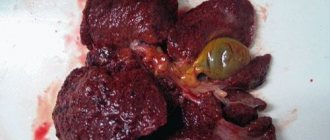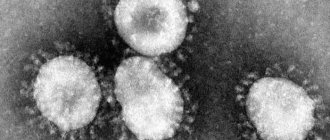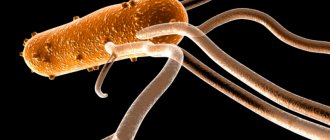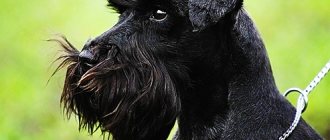Gastroenteritis in dogs is a disease of the gastrointestinal tract of predominantly infectious etiology, accompanied by the progression of inflammatory foci, spasmodic pain and indigestion against the background of severe intoxication of the whole body.
The disease is an inflammatory process of the mucous membrane of the stomach and intestines. Most often it occurs spontaneously and occurs in an acute form. In advanced stages of gastroenteritis in a dog, the inner layer of the stomach and intestinal muscles is deformed, which leads to a malfunction of the digestive system and dysfunction of secretion.
How and why dogs get gastroenteritis
The most common cause of the disease is viral or bacterial infection. The main risk group for contracting gastroenteritis includes puppies, elderly and adult compact (small) breeds.
Infection with microbes occurs due to ingestion of low-quality or dirty food, overeating or vitamin deficiency. For example, a dog will eat rotten food while walking, which will provoke acute poisoning and initiate the process of inflammation of the gastrointestinal mucosa. With systematic vitamin deficiency, the dog does not receive enough vitamin supplements in the food necessary for growth and development, which disrupts metabolic processes in the body and reduces immune defense. A weak pet is most often susceptible to infection from the outside and is not able to resist diseases without appropriate treatment. Oversaturation of food in a pet’s diet leads to digestive dysfunction, which affects intestinal patency and motility. Stagnant masses are often sources of bacterial development and, as a consequence, the appearance of an inflammatory process.
The source of viral infection in a healthy dog can be a dog with gastroenteritis. The carrier of gastroenteritis is active from the moment of infection and excretes the pathogen through vomit and feces throughout the entire period of the disease.
The secondary form of development of symptoms of gastroenteritis in a pet is considered to be repeated endoparasitic invasions, pathologies of viral origin, chemical poisoning or volvulus.
It is especially dangerous for a dog to become infected with a coronavirus or parvovirus infection. If left untreated, the pet may die within 2–3 days after infection.
An advanced form of gastroenteritis is the cause of the development of intestinal plague, and a high probability of death cannot be ruled out.
Veterinarians say the main reason for a pet’s death from infection is a late visit to the doctor.
Veterinary research has proven in practice that more than 95% of adult dogs have been cured of viral gastroenteritis. The survival rate among one-year-old puppies is lower. This depends on the resilience of the dog’s young body and the degree of advanced disease at the time of treatment.
Remember, the speed of contacting a veterinarian after detecting the first signs of illness depends on the life of your pet.
What is gastroenteritis
Gastroenteritis in dogs is an inflammatory disease of the stomach and intestines. There are several types of illness: parvovirus, coronavirus, viral, purulent, phlegmonous, secondary, primary, acute, chronic, hemorrhagic. The disease mainly affects the submucosal, mucous, and muscular layers of the stomach and intestines. This disease occurs in different breeds of animals, but most often it affects representatives of small breeds, for example, toy terriers, pinschers. Gastroenteritis occurs more often in young animals, and the older the pet, the less often the disease manifests itself.
Types of gastroenteritis
According to viral etiology and degree of localization of pathology, gastroenteritis is divided into types:
- Membranous mucous.
- Diphtheric.
- Purulent.
- Croupous.
- Hemorrhagic.
- Phlegmonous.
- Mixed type.
Based on the analysis of the history of occurrence and the method of progression, gastroenteritis is classified as primary or secondary, chronic or acute.
If a parvovirus or coronavirus infection is suspected, the dog is subject to PCR tests.
Parvovirus gastroenteritis
A dangerous disease that has a massive spread similar to an epidemic. The causative agent is a virus, has low sensitivity to external influences, and dies only under the influence of boiling temperature.
In mild forms of the disease, the dog experiences severe apathy, loose stools and lack of appetite; with timely treatment, the condition stabilizes by the 5th day of the disease. In severe forms of parvovirus gastroenteritis, the animal is characterized by such symptoms as diarrhea up to 6–8 times a day, complete refusal of food, vomiting up to 5 times a day (in the vomit there is gastric mucus and remnants of undigested food), spasmodic pain in the abdomen, salivation and fever up to 40 degrees. With treatment, the dog’s condition returns to normal within a week.
Coronavirus gastroenteritis
A highly contagious pathology, it causes rapid dehydration, general intoxication and exhaustion against the background of rapidly developing inflammation of the gastrointestinal tract. In the absence of timely treatment, there is a high probability of death (after 2–3 days from the onset of symptoms). One-year-old puppies and adult animals with weak immune systems are at risk. A characteristic sign of the open form of coronavirus gastroenteritis is vomiting and stool with blood and mucus.
In the latent form of viral gastroenteritis, there are symptoms of weakness, lack of appetite, lethargy and low-grade fever.
Coronavirus gastroenteritis is especially dangerous for two-month-old puppies. The animals have virtually no chance of survival; death occurs within 48 hours.
How is hemorrhagic gastroenteritis treated?
Dogs with hemorrhagic gastroenteritis become very seriously ill and, if treatment is not started in time, may die.
Dogs with hemorrhagic gastroenteritis become very seriously ill and, if treatment is not started in time, may die. In most cases, the disease is better tolerated if the dog receives supportive treatment. Treatment is based on intravenous fluid therapy and electrolyte replacement. Subcutaneous fluid administration is usually not sufficient to restore fluid balance in affected dogs. Most dogs should not be fed for 24 hours of treatment and should be given antibiotics such as ampicillin, enrofloxacin or metronidazole to combat potential secondary intestinal infection. Additional therapy may consist of antiemetic drugs. In severe cases, plasma or colloids may be needed to restore blood protein levels.
If the dog does not receive intravenous fluid therapy, the red blood cell count will continue to rise due to dehydration. In this case, the dog may suffer from disseminated intravascular coagulation (DIC), an irreversible disorder that can lead to the death of the animal.
How to detect in a dog
According to veterinarians, each dog reacts differently to the disease. Depending on the etiology of occurrence, age and physical health of the dog, the symptoms of the disease may develop non-standardly.
Common signs of gastroenteritis in a pet include:
- Weakness and refusal to eat. An initial sign of animal behavior that should alert you.
- Vomiting and diarrhea. Constant gag and fecal reflexes exhaust your pet. Diarrhea is often accompanied by increased gas formation and spasmodic acute pain in the intestinal area. An admixture of blood and mucus in the stool means a pathological localization of the source of infection in the rectum, which is typical for coronavirus gastroenteritis. Watery brown stools indicate localization of the inflammatory process in the small intestine.
- Drinks a lot. When the pathogen multiplies intensively, the body becomes severely dehydrated, and the dog requires water to replenish the water-alkaline balance.
- Pain syndrome. When trying to palpate the abdomen, the dog becomes nervous and aggressive. The abdominal wall is tense to the touch, spasms inside are accompanied by gurgling sounds.
- Temperature increase. On the first day of infection, a stable low-grade fever remains. A symptom of the dog's weakness and refusal to eat should alert you. Subsequently, there is a possibility of a rapid increase or decrease in temperature. These fluctuations are very dangerous symptoms; the pet urgently needs urgent medical attention.
- Sudden weight loss. Against the background of the asymptomatic onset of the disease, the dog refuses to eat and becomes passive. If other signs are less pronounced, but the dog is rapidly losing weight, you should immediately consult a veterinarian.
Causes of gastroenteritis in dogs
The reasons that provoke the appearance and development of gastroenteritis include:
- toxic poisoning of a dog. When chemicals enter the stomach, the mucous membrane burns. Under the influence of an acidic environment, the affected areas become inflamed, causing dysfunction of the entire gastrointestinal tract;
- helminthic infestations. During the life of helminths, harmful amino acids are released that can injure the intestinal mucosa;
- gastroenteritis of a traumatic nature. Occurs against the background of internal injuries caused by swallowing objects and bones. In the absence of effective treatment, the pathology is complicated by intestinal obstruction.
- chronic intoxication of the body. Occurs against the background of oncological processes, liver diseases, kidney diseases, and other advanced pathologies;
- drug-induced gastroenteritis. Appears due to long-term use of antibiotics, cytostatics or other anti-inflammatory drugs.
Causes
There are primary and secondary causes of the disease. Primary ones include:
- Violations of a balanced diet, namely eating too often or simply feeding too much, a sudden change in food, or a diet that includes exclusively boiled or fried food.
- Oral diseases, dental problems.
- The food temperature is too high or low for the animal.
- Food of poor quality (spoilt foods are especially dangerous).
Moreover, gastroenteritis may well be triggered by serious poisoning of the body. Various pesticides, soil amendments, fertilizers, and insect control products can lead to intoxication. The risk of poisoning increases greatly if the dog lives outside the city.
In some cases, this disease can develop as a result of taking certain medications, for example, painkillers and strong antibiotics.
As for secondary signs, they are often associated with the internal environment, as well as processes and changes occurring in the animal’s body.
They could be:
- Infections
- Kidney failure (leads to insufficient production of hormones involved in digestion)
- Pancreatic diseases
- Allergies
- Problems with the circulatory system and heart, which lead to a general lack of blood necessary for the mucous membranes of the body.
- Intestinal harmful organisms producing toxic substances
- Lack of vitamins
- Wounds or burns.
Diagnosis of gastroenteritis in dogs
Diagnosis of this disease in dogs is carried out through a comprehensive examination. First, the animal’s life history is clarified, the veterinarian collects data on the pet’s diet, vaccination, living conditions and walking conditions.
The diagnosis is made based on:
- clinical examination - palpation of the gastrointestinal tract, thermometry and auscultation;
- data from laboratory analysis of biochemistry and TCA of blood, stool studies;
- survey ultrasound of the abdominal cavity, gastroscopy and, if necessary, radiography.
Laboratory tests assess the degree of damage to intestinal functionality, the stage of development of inflammatory processes, and determine the type of pathogen. Ultrasound data makes it possible to assess the level of damage, the localization of foci of gastrointestinal infection, and also identify the expected complication in the form of intestinal obstruction or adhesions. Visual diagnostic methods are used to clarify the diagnosis.
Diagnostics
Finding out the cause of the pathology begins with collecting an anamnesis. Information about the age of the dog, the date of the last deworming, when and with what vaccine it was vaccinated is informative. Has the dog breeder made any attempts to deal with indigestion on his own and what means have he used?
If the medical history and observed symptoms are not enough to make a diagnosis, additional tests are prescribed:
- Feces.
- Urine.
- Blood.
- PCR diagnostics.
- Ultrasound of the abdominal chamber.
- Toxin analysis.
- Determination of the sensitivity of the pathogen to antibiotics.
Treatment of gastroenteritis
The method of treating a disease in a dog includes complex medicinal methods aimed at stopping the root causes of the disease and eliminating systemic disorders of the digestive process.
If a viral genesis is detected in the dog, antiviral and immunostimulating therapy is carried out. Chemical gastroenteritis is treated by flushing the gastrointestinal tract, using antidotes and symptomatic drug support for the body. Infection with helminths is controlled by antiprotozoal and anthelmintic drugs.
If the cause of gastroenteritis was a foreign body entering the intestine, the veterinarian decides on surgical intervention or rectal removal of the object.
Gastroenteritis against the background of chronic pathologies is treated conservatively with the help of antiemetics, strengthening drugs and eliminating dehydration. At the same time, antibiotics are prescribed to relieve inflammation and immunomodulatory agents to support the immune system.
Simultaneously with drug therapy, systematic immunomodulatory treatment is carried out with auxiliary means of mechanical cleansing of the body - enemas based on herbal decoctions (chamomile, St. John's wort, calendula). The procedure quickly clears the intestines of fragments of liquid feces, soothes muscle tone, restores intestinal motility and reduces pain.
Drug therapy
Drug therapy involves the use of a wide range of drugs. Conservative treatment is prescribed by a veterinarian depending on the typology of the pathogen and the degree of development of gastroenteritis.
- Antimicrobial drugs. The drugs of the tetracycline or penicillin series are mainly used - Biseptol, Levomycetin, Furacilin, Fthalazol.
- Adsorbents.
- Painkillers.
- Enveloping drugs.
- Enzyme-containing medications.
- Antihistamines.
You should know that the decision to prescribe a specific drug is made only by a veterinarian, based on clinical and laboratory data on the pet’s condition.
It is not recommended to treat your dog yourself - many medications have side effects and can harm the animal.
If there is a clinical picture of severe dehydration, the pet is injected with Ringer's solution. The symptom of loss of appetite is relieved with meat broth or rice water, as well as vitamin and electrolyte infusions.
To maintain the water-alkaline balance of your pet, before the veterinarian arrives, you can make a special remedy at home. For 1 liter of boiled water, take 1.5 grams of calcium chloride, 2.5 grams of soda, 3.5 grams of salt and 20 grams of sugar. You can give the animal a solution of no more than 40 grams of solution per 1 kg of live weight until the liquid feces disappear completely.
Diet therapy
During the treatment period, the dog needs a well-balanced and high-quality diet. Therefore, during symptomatic therapy, the dog is prescribed a gastroenterological industrial diet.
How to plan a diet for a sick pet
To ensure the effectiveness of treatment, along with drug therapy, the pet is given a special diet.
- In the first days of treatment, to support the body and eliminate dehydration, the dog is given infusion therapy and given only water to drink.
- On the 2nd day, the introduction of herbal decoctions of flax, chamomile, chaga and meat broths is allowed.
- Boiled chicken eggs are added to the diet for 3–4 days of treatment, at the rate of 3 eggs per day for an adult dog.
- Subsequently, the dog is given rice or oatmeal porridge with meat broth, fermented milk products, and lean minced meat.
- After a week, boiled vegetables are introduced into the animal’s diet.
- If the outcome of conservative therapy is favorable, after a week and 10 days the dog is transferred to its usual diet.
- After treatment, for the first month it is recommended to refrain from feeding the dog peas, beans, bones and raw vegetables.
It is important to know that during the first months after recovery, when walking with your pet, stop his attempts to gnaw on foreign objects or chew grass. The precaution is necessary to prevent re-infection while the body's immune system is recovering.
Feeding an animal with gastroenteritis
Diet is one of the most important components of treatment. A dog that begins to show an appetite is definitely on the road to recovery. However, at the beginning of treatment, the amount of food should be strictly dosed. During the first day, the animal can be given only water and medicinal solutions. In the future, you can switch to broths and liquid foods in general. Herbs will be a good addition to the diet.
A few days after the start of therapy, the diet can be supplemented with eggs (raw and boiled), about 2-3 per day. If your dog has allergies, you should refrain from taking an extra dose of protein. After a few days, you can give your dog porridge, rice or oatmeal. If the dog accepts this food adequately, you can add a small amount of minced meat to the cereal.
After a week, the animal can already eat dairy products; for example, at this stage the body reacts positively to low-fat kefir. You can also add milk to the porridge. A little later, the diet must be supplemented with vegetables (exclusively boiled). Following the dog’s usual diet is possible only two weeks after therapy.
Food should be given in portions, up to 6 times a day. The presence of salt or vitamins should vary depending on the condition of the dog. Bones, nuts, and raw vegetables should be excluded during treatment. You should also not allow your dog to eat grass, as this can lead to a new outbreak of gastroenteritis. During the entire recovery period, the dog should be regularly observed by a veterinarian - this will prevent possible problems with the vascular and heart systems, as well as disturbances in the functioning of the gastrointestinal tract.
Thus, several rules and main stages of treatment of gastroenteritis can be identified:
- Emptying the dog’s stomach and intestines of food debris so that they do not irritate the body’s environment.
- Daily fasting.
- Portioned feeding during therapy, allowing the affected and weakened digestive system to accept incoming food.
- Maintaining fluid balance.
- Grinding food to avoid injury to the digestive tract. Bones must be excluded.
- Complete exclusion of fiber, which is found in cereals, legumes and carbohydrates in dairy products.
- Reducing the amount of fatty foods.
- Limiting the amount of protein in the diet during the initial stages of treatment. Towards the end, you can give it even a little more than normal.
- Minimum number of different elements in the diet.
- Drugs are prescribed exclusively by a doctor after a detailed examination and assessment of the dog’s condition.
Mild forms of the disease pass quickly and with virtually no complications, but subsequently can affect the dog’s life. Owners should not self-treat animals to avoid misdiagnosis and possible deterioration of their pets’ condition. It is strongly recommended not to give your dog any self-selected medications. A quick visit to the veterinarian can not only make the animal’s life easier, but even save it.
Disease prevention
Preventative measures for canine gastroenteritis include:
- Regular external and internal antiparasitic treatment of the dog.
- Stable vaccination schedule for puppies and adults.
- Feed quality control.
- Disinfecting dog toys.
- Balanced diet.
If you have the slightest suspicion of illness, contact your veterinarian immediately. Do not self-medicate and do not waste time waiting for it to “go away on its own.”
Prevention
Preventive measures include regular vaccination, quarterly deworming, and a balanced diet. The dog should not go out for a walk hungry; it should be taught not to take food from the ground.
We invite you to join our Zen channel and group on VKontakte or Odnoklassniki, where new articles for pet owners are published.
Similar articles:
- What is separation anxiety in dogs and how to deal with it?
- Tuberculosis in dogs
- Umbilical hernia in dogs










